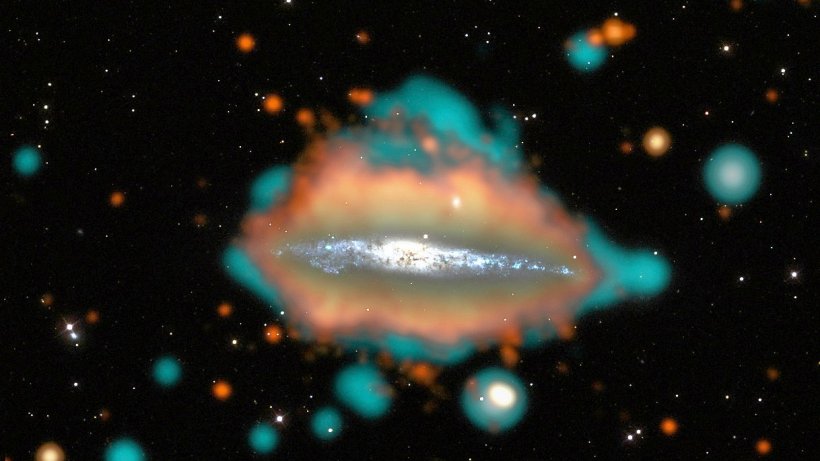Thuringian researchers are looking for new stars
The whale galaxy NGC 4631 has three different wavelength bands: star formation in the galaxy produces hot gas visible in X-rays (blue) and high-energy particles seen in radio (orange). In the center is a visible light image of the galaxy.
Photo: Volker Hessen/Michael Stein/Hamburger Observatory
Tautenberg.
The Thuringian State Observatory in Tautenberg is currently working on a new sky map of 4.4 million galaxies.
Seven billion years – that’s how far back the view of the universe goes on a new map of the sky published by researchers. The data comes from the world’s largest Lofar radio telescope. They are recorded by grid-connected measuring stations in Poland, Ireland, France, Sweden, Latvia and others – as well as at the Thuringian State Observatory in Tautenberg (TLS). As part of Lofar, 96 antennas at the observatory ten kilometers northeast of Jena have been searching the sky for information about the formation and evolution of galaxies for four years. The continuously recorded radio wave ratings are combined with the ratings of all participating stations in the Juwels high-performance Jülich computer, currently Europe’s fastest supercomputer, over a 10 gigabit data line. The Mastermind now envisioned the most complex celestial picture yet under the Thuringian leadership.
TLS astronomer Matthias Hoeft describes the result as an overlay of different time slices into a single image. You can see galaxies in the northern sky, that is, the sky over the hemisphere north of the equator. The oldest of these galaxies are up to seven billion years old. Supermassive black holes or very powerful star-forming regions can be observed in galaxies. Thus 4.4 million galaxies became visible in the radio wave band. A million of these galaxies were completely unknown before, as well as many discoveries and objects that the human eye has not seen. “If the data were only evaluated from one station, the result would be somewhat disappointing. Lofar communication provides us with high accuracy and thus a fantastic view of the history of the universe,” said Hooft. Overall, the research groups evaluated the recordings from 3,500 hours of monitoring—the amount of data that would fill 20,000 laptop hard drives.
To date, 27 percent of the recorded data has been mapped. According to Hovet, the image of the sky can be completed in a few years. The wealth of information has already been demonstrated by recent scientific works. Sky Map is the most comprehensive study to date of colliding galaxy clusters – the largest structures in the universe – containing hundreds to thousands of galaxies. In addition, so-called “jellyfish galaxies” have been observed, which lose dust and gas during their journey through an intergalactic medium.
lofar-surveys.org
www.tls-tautenburg.de

“Travel maven. Beer expert. Subtly charming alcohol fan. Internet junkie. Avid bacon scholar.”







More Stories
The ranking of the best survival horror games selected by the IGN US editorial team has been released! Resident Evil RE:2 ranked first
Enjoy a hot cigarette while looking at whales and tropical fish under the sea ⁉︎ “Ploom Dive” is an amazing spatial video experience using Apple Vision Pro
Apple Watch now supports sleep apnea, watchOS 11 released – Impress Watch